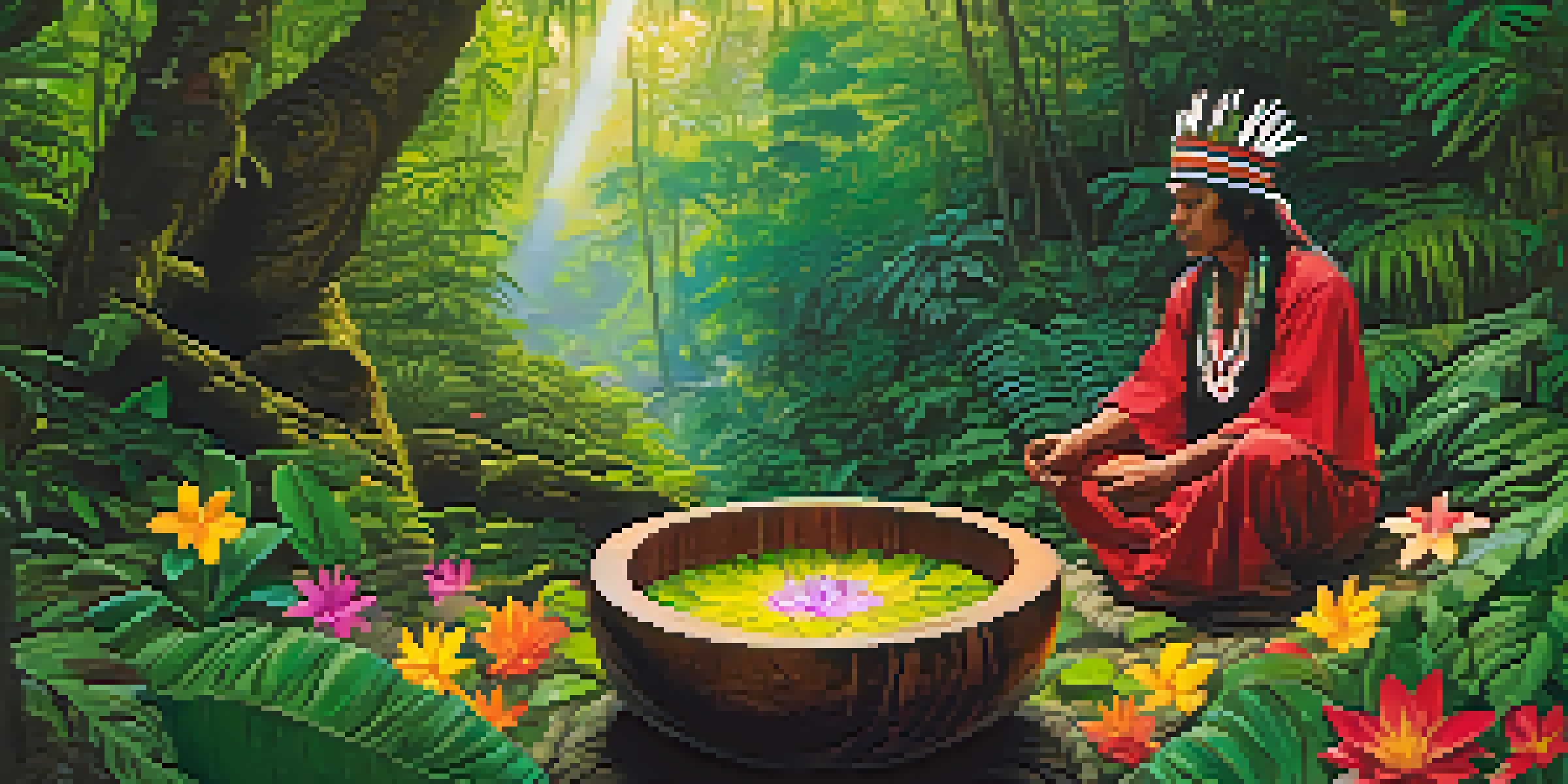Ayahuasca vs. Ketamine: Cultural Perspectives on Their Use

Understanding Ayahuasca: Roots in Indigenous Culture
Ayahuasca, a powerful brew made from the Banisteriopsis caapi vine and other plants, originates from Indigenous cultures in the Amazon rainforest. For centuries, it has been used in traditional ceremonies for spiritual healing and connection to the divine. This rich cultural heritage emphasizes the importance of community and the shaman's role in guiding participants through their journeys.
The greatest discovery of my generation is that a human being can alter his life by altering his attitude.
The brew contains DMT (dimethyltryptamine), a psychedelic compound that induces vivid visions and profound insights. These experiences can lead to emotional healing and personal growth, often framed within the context of Indigenous beliefs about nature and interconnectedness. Participants frequently report transformative experiences that reshape their understanding of self and the world around them.
In contrast to Western medicinal practices, Ayahuasca ceremonies are deeply communal, often involving rituals, music, and shared experiences. This collective approach fosters a sense of belonging and support, which is crucial for many participants. The cultural significance of Ayahuasca is thus intertwined with its therapeutic effects, creating a unique healing environment.
Ketamine: A Modern Approach to Mental Health
Ketamine, originally developed as an anesthetic, has garnered attention in recent years for its rapid-acting antidepressant properties. Unlike traditional antidepressants, which can take weeks to show effects, ketamine can provide relief within hours, making it a game-changer for those suffering from severe depression. This has led to its use in clinical settings, often in the form of infusions or nasal sprays.

While its use is rooted in modern science, ketamine treatment lacks the cultural rituals and communal aspects found in Ayahuasca ceremonies. Instead, it is typically administered in clinical environments, where patients are monitored by healthcare professionals. This medical framework emphasizes safety and efficacy, catering to individuals seeking quick relief from debilitating symptoms.
Ayahuasca's Cultural Significance
Ayahuasca is rooted in Indigenous traditions, promoting community and spiritual healing through guided ceremonies.
Despite its promise, the rise of ketamine as a treatment raises questions about the long-term implications of its use. Critics argue that, without addressing underlying issues, reliance on a pharmaceutical solution may not be sustainable. As awareness of mental health continues to grow, the conversation around ketamine's role in this landscape remains dynamic and evolving.
Comparing Therapeutic Outcomes: Ayahuasca vs. Ketamine
Both Ayahuasca and ketamine have been shown to produce significant therapeutic outcomes, but they do so through very different mechanisms. Ayahuasca often leads to introspection and emotional release, allowing participants to confront deep-seated traumas and unresolved issues. Meanwhile, ketamine acts on the brain's neurotransmitters to provide immediate relief from depressive symptoms.
Healing is a matter of time, but it is sometimes also a matter of opportunity.
Research indicates that individuals who undergo Ayahuasca ceremonies may experience lasting changes in their mental health, often reporting a greater sense of well-being and connectedness. On the other hand, ketamine's effects are usually more acute, providing quick relief but often requiring follow-up treatments for sustained benefits. This difference highlights the distinct approaches each treatment takes toward mental health.
Ultimately, the choice between Ayahuasca and ketamine may come down to individual preference and the specific context of treatment. Some may seek the spiritual and communal aspects of Ayahuasca, while others may prioritize the immediacy and clinical oversight that ketamine offers. Both paths have their merits, and understanding these can help individuals make informed decisions about their mental health journeys.
Cultural Context: The Role of Set and Setting
In both Ayahuasca and ketamine experiences, the concepts of 'set' (the individual's mindset) and 'setting' (the physical and social environment) are crucial to the outcomes. For Ayahuasca, the ceremonial setting—with its rituals and guidance from a shaman—creates a sacred space conducive to healing. This cultural backdrop enhances the emotional and spiritual dimensions of the experience.
Conversely, ketamine treatments are usually conducted in sterile, clinical environments designed to promote safety and comfort. This setting aims to reduce anxiety and facilitate the therapeutic effects of the drug. While the clinical approach is effective for many, it lacks the communal and spiritual elements that characterize Ayahuasca ceremonies.
Ketamine's Rapid Relief
Ketamine provides quick antidepressant effects, often within hours, differing from traditional treatments that take longer.
Understanding the importance of set and setting helps clarify why individuals may resonate more with one treatment over the other. For some, the communal and ritualistic aspects of Ayahuasca may provide a deeper sense of healing, while others may find the clinical, evidence-based approach of ketamine more appealing. Each person's journey is unique, shaped by their personal beliefs and experiences.
Potential Risks and Considerations
Both Ayahuasca and ketamine come with their own set of potential risks and considerations that must be acknowledged. Ayahuasca can induce intense psychological experiences that may not be suitable for everyone, particularly those with certain mental health conditions. Additionally, the unregulated nature of some Ayahuasca ceremonies can pose risks regarding safety and the quality of the brew used.
On the other hand, while ketamine is generally considered safe when administered by qualified professionals, it can lead to dissociative experiences and potential long-term effects on memory if misused. The rise of at-home ketamine treatments also raises concerns about proper oversight and the potential for misuse, highlighting the importance of finding a reputable provider.
Understanding these risks is crucial for individuals considering either treatment. Both pathways can offer significant benefits, but it's essential to approach them with awareness and caution. Consulting with healthcare professionals or knowledgeable guides can help ensure a safer and more effective experience, regardless of the chosen method.
Integration: Moving Beyond the Experience
Integration refers to the process of making sense of and applying insights gained from Ayahuasca or ketamine experiences to everyday life. For Ayahuasca participants, this often involves reflecting on their journey and finding ways to incorporate newfound wisdom into their daily routines. Group integration sessions can also provide support and community, helping individuals process their experiences together.
In the case of ketamine, integration may involve therapy sessions that help individuals reflect on their experiences in the clinical setting. This can be particularly valuable in addressing the underlying issues that led to seeking treatment. Therapists can assist patients in developing coping strategies and understanding the implications of their experience.
Integration is Key for Healing
Both Ayahuasca and ketamine require effective integration of experiences to ensure lasting mental health benefits.
Regardless of the method used, integration is a crucial step in ensuring lasting benefits from these experiences. Both Ayahuasca and ketamine offer opportunities for profound change, but the real work often begins after the experience ends. By actively engaging in integration, individuals can bridge the gap between their insights and their daily lives, leading to more meaningful long-term outcomes.
The Future of Ayahuasca and Ketamine in Mental Health
As the conversation around mental health evolves, both Ayahuasca and ketamine are gaining recognition for their potential therapeutic benefits. Research into the efficacy and safety of both treatments is expanding, paving the way for a more nuanced understanding of how they can be integrated into mental health care. This growing interest is prompting discussions about the importance of cultural sensitivity and ethical considerations in treatment.
The future may see a more collaborative approach to mental health, where traditional practices like Ayahuasca are respected alongside modern medical treatments like ketamine. This integration could lead to a more holistic understanding of mental health, one that honors both cultural traditions and scientific advancements. As more people seek alternative treatments, the dialogue around these substances is becoming increasingly important.

Ultimately, the journey toward understanding and utilizing Ayahuasca and ketamine in mental health is ongoing. As we navigate these waters, it’s essential to remain open to new insights and perspectives, ensuring that both cultural significance and clinical efficacy are honored. The future of mental health treatment may well lie in the convergence of these two worlds, offering hope and healing to many.